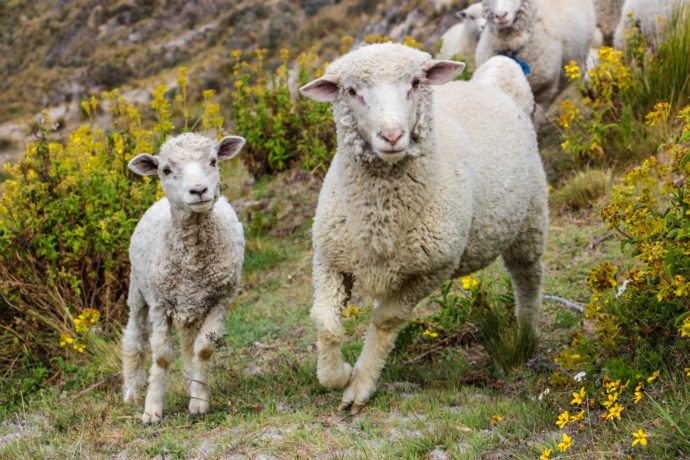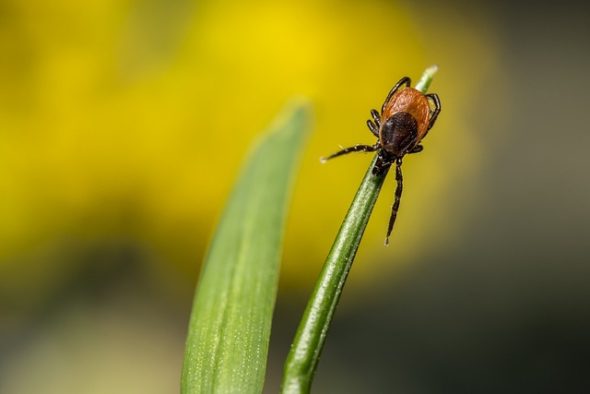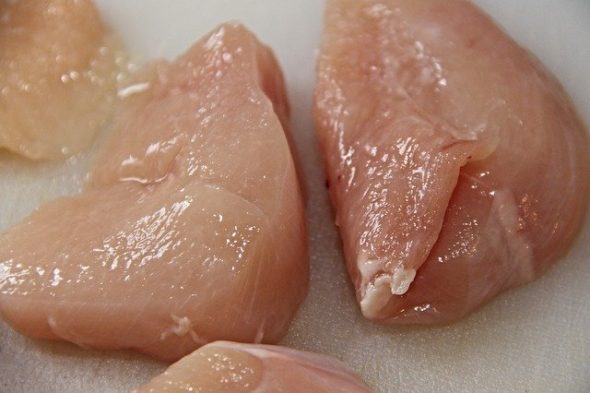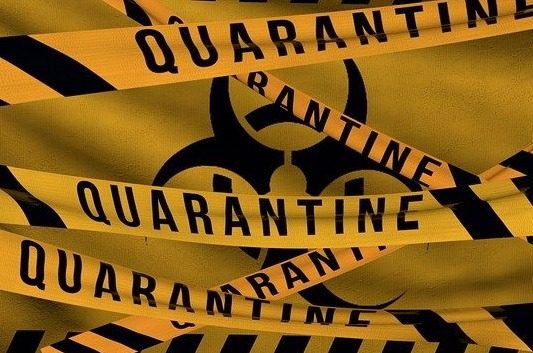While it is important that the food we eat is healthy and safe, we must also consider the health and welfare of food-producing animals such as cattle, sheep, poultry and pigs. This is very important ethically but also to ensure there is sufficient food available, at a low enough cost for people to afford a nutritious diet. This is known as food security.
At a local level, diseases can cause economic losses to farmers that can severely affect their livelihood. On a global level, diseases such as foot and mouth disease and African swine fever, which are both caused by viruses, can be so catastrophic that they can directly impact on the availability of food for large numbers of people.

Causes
Farm animal diseases can be caused by pathogenic (disease-causing) bacteria, viruses, fungi and protozoa. Prions can also cause disease in animals. A prion is a protein that triggers proteins in the brain to fold differently, causing damage and disease. Prion diseases include scrapie in sheep and bovine spongiform encephalitis (BSE) in cattle. As well as microbes, livestock diseases can also be caused by larger parasites such as worms, flukes or ecto-parasites which live on the skin. Sometimes animals are infected by more than one of these infectious organisms causing a “disease complex” which can be difficult to diagnose and treat.
Infectious farm animal diseases in Scotland
Animals are susceptible to lots of different types of disease, just like humans. These include respiratory diseases, enteric diseases that affect the digestive system, reproductive diseases, skin infections and urinary infections. Animals that produce milk can suffer from mastitis (infection of the udder) and some infections can affect the central nervous system.
Gut infections, which often cause diarrhoea, are very common. Bovine viral diarrhoea has affected large numbers of cattle in Scotland and scientists, vets and farmers are currently working together to eradicate it from Scottish farms. Cryptosporidium also affects cattle and the disease can be very serious in neonatal (newborn) animals, which can die due to dehydration and malnutrition caused by the disease.
Some infections cause poor growth and wasting such as Johne’s disease in cattle, sheep and goats. This disease impacts on milk production and infected animals are more vulnerable to other infections. Advanced disease results in diarrhoea, wasting and eventually death. Johne’s disease is caused by Mycobacterium avium subspecies paratuberculosis, which is closely related to the bacterium that causes tuberculosis in humans.
Infections can also cause spontaneous abortions or lead to infertility, where the animal cannot produce offspring. Some microbes that cause sheep abortion can also infect humans, including the bacteria Chlamydia abortus and the protozoan parasite Toxoplasma gondii. For this reason, pregnant women are advised to avoid contact with sheep, especially during lambing season.

Ticks can also spread diseases. Ticks are blood-sucking arachnids and are related to spiders, scorpions and mites. To survive and complete their life-cycle, they require a blood meal and feed on animals and humans. Different tick species prefer different species of animal and in the UK, there are at least 20 different species of tick. The most common is the “Sheep Tick” (Ixodes ricinus), which feeds on a wide range of hosts including sheep, cattle, deer, small rodents, hedgehogs, squirrels and humans. This tick can transmit several diseases that affect livestock, including louping ill, which is caused by a virus and tickborne fever, caused by the bacteria Anaplasma phagocytophilum. Ticks prefer warm wet conditions and there is concern that changes in climate may result in an increase in ticks and the diseases they carry.
Importance of animal welfare
Animals that are farmed with high standards of welfare can often resist infections but animals become more susceptible to diseases when their health is undermined by farming practices that impact on their welfare. It is therefore important that the five freedoms of animal welfare are maintained, which includes freedom from hunger and thirst, freedom from discomfort, freedom from pain, injury and disease, the freedom to express normal behaviour and freedom from fear and distress. Animals must also be well nourished with access to enough water so their immune systems can fight off infection.
Housing is very important and animals must have enough space to allow natural patterns of behaviour. Housing materials such as hay must be replaced regularly or they can accumulate dangerous pathogens. Good ventilation is also important; poor housing is often a factor in respiratory diseases such as pneumonia, which is common in poultry, and ovine pulmonary adenocarcinoma in sheep, caused by a virus called the Jaagsiekte Sheep Retrovirus. Other factors, such as flooring are also important. Standing on hard surfaces can cause lameness that can also lead to other problems including mastitis. Intensive animal farming, where animals are stocked at high density is thought to increase the spread of diseases and lead to emergence of pathogenic bacteria and viruses, including some that can also cause disease in humans.
Animals which are stressed are known to be more susceptible to disease as stress affects the normal functioning of immune responses. Stress can be caused when animals cannot express their normal behaviour patterns, for example when a chicken does not have enough space to spread its wings. Animals also become stressed when they are too hot. For this reason, effects of climate change are very concerning for farmers and it is vitally important that they are able to protect their animals from extremes of weather.

Zoonotic infections
Zoonotic infections are diseases that are spread to humans from animals. Sometimes, microbes that cause disease in humans do not affect the animals that carry them. People often become infected though contaminated meat products; this is known as foodborne disease. People can also become infected from contact with infectious animals or contaminated material such as bedding and disease can spread through the environment via contaminated water. Ticks can also transmit zoonotic microbes to humans. Over recent years, people have become more aware of the connections between humans, animals and the environment and this is known as One Health.
Multicellular parasites
In addition to microbes, multicellular parasites are also a major cause of infectious diseases in livestock. These include worms such as Teladorsagia circumcincta, which has a major impact on sheep and goat health and flukes such as Fasciola hepatica, which causes severe liver damage in sheep. Ecto-parasites such as Psoroptes ovis, which causes sheep scab, and poultry red mite (Dermanyssus gallinae) can also live on the surface of animals and cause significant health problems. Infections with parasites often lead to secondary infections, for example bacterial infections following sheep scab infestation.
Global spread
There are a variety of ways that diseases can spread over the globe. Human activities can result in the spread of disease, for example through travel and the importation of meat products. Another route is through disease vectors such as mosquitos, ticks and midges and migratory animals such as geese are able to carry disease causing microbes including avian influenza viruses, which causes bird flu. In the UK, veterinary surveillance laboratories record the incidence of animal diseases and consult with similar laboratories in other countries to monitor the spread of emerging diseases such as bluetongue in livestock, which is caused by a virus that is transmitted by midges. Scientists are also working to understand the potential impact of climate change on the spread of disease.


Disease control
Using correct biosecurity measures is a very effective way to reduce spread of infections. Correct diagnosis of disease is very important so animals can be treated appropriately and quarantined if necessary.
Diagnostic tests are also used when farmers purchase new animals to ensure that infected animals are not introduced to healthy flocks and herds. Vaccines are also used to prevent disease in animals. They must be easy for farmers and vets to administer and affordable.
Many diseases are treated with drugs called antimicrobials that kill or inactivate the infectious agent. Some microbes and parasites can become resistant however, which means that sometimes infections cannot be treated. There is also concern that antibiotic resistant bacteria that emerge on farms can be transmitted to humans. Preventing disease by using vaccines and diagnosing diseases correctly avoids the overuse of antibiotics and resistance developing.
Read also

Foodborne pathogens
Foodborne pathogens
Foodborne illness can be caused by a wide variety of different microbes. Some microbes produce toxins which can also cause illness.

Foodborne pathogens
Antibiotic resistance
Antibiotics are used to treat bacterial infections but bacteria are becoming resistant to these drugs and some infections can no longer be treated.

Farming and environment
Crop diseases
Microbes can also cause plant diseases and farmers work hard to keep their crops protected.